MARKET OVERVIEW
The global defense unmanned undersea vehicle (UUV) market is poised to receive growing interest as countries invest in advancing their undersea capabilities. It will involve the area of maritime defense where robotic submersible vessels cruise without a human on board, performing activities such as surveillance, reconnaissance, mine detection, and data gathering. This industry will be at the intersection of future robotics, underwater acoustics, sensor systems, and military forces, and it will change with changing defense priorities and capabilities. In the future, the global defense unmanned undersea vehicle (UUV) market will be characterized by integrating higher levels of sophistication in autonomy and endurance. Ships will travel deeper and last longer than existing platforms allow. They will be equipped with better battery systems or alternative energy solutions, enabling longer-range and more complicated missions. These ships will drive themselves with augmented artificial intelligence that will facilitate onboard decision-making in doubtful circumstances underwater.
With navies in search of safer means of monitoring undersea areas, the global defense unmanned undersea vehicle (UUV) market will attract attention for its potential to replace crewed ships in dangerous environments. Port defense systems, submarines, and undersea surveillance posts can depend on unmanned assets to fill gaps in detection or map subsea terrain prior to deploying human-crewed vessels into a region. This will revolutionize threat analysis and operational planning. Underwater drone designers will concentrate on modular construction that will allow for quick sensor changeovers and mission reorganization.
A vessel may begin a mission with sonar, transition to chemical sensors, and finally use cameras all in the same hull without having to go back to base. This flexibility will become a calling card of what the worldwide Defense Unmanned Underwater Vehicle (UUV) marketplace will provide. It will enable forces to react rapidly to evolving underwater challenges, from identifying recalcitrant ships to scrutinizing seabed conditions. In addition, stealth and low acoustic signature will become an increasingly focused emphasis. Next-generation craft will be designed with materials and propulsion methods that will restrict noise and minimize detectability. This tactic will enhance intelligence gathering in hostile waters without alerting aggressors to their existence. That capability will create a requirement for undersea systems that can slide through littoral environments unseen. Interoperability across nations will propel common standards for communication protocols, mission interfaces, and vehicle interoperability. Naval vessels would probably utilize interoperable autonomous platforms that will function together during joint exercises or actual missions. Ships of one navy will share sonar data with the command ship of another nation, and they will coordinate in real time even if they sail out of range of each other's direct visual sight.
Moreover, sensor complexity will rise. Cars will have multi-modal payloads combining acoustic, magnetic, and optical sensors to sense objects and anomalies at distances or in high-noise environments. Signal processing will be augmented with AI to support real-time processing, such that command centers will only have information of relevance without bandwidth overload. That will improve decision-making support and lower operator cognitive load.
In the future, the global defense unmanned undersea vehicle (UUV) market will be an expression of changing boundary conditions in war. These systems will become central to maritime domain awareness and security. As platforms become more autonomous, long-lasting, and stealthy, this market will redefine how undersea activity is carried out. Operations that previously involved manning by human crews will be reconfigured as coordinated fleets of smart submersible drones, working together to secure seas and collect vital information.
Global defense unmanned undersea vehicle (UUV) market is estimated to reach $9,984.06 Million by 2032; growing at a CAGR of 10.8% from 2025 to 2032.
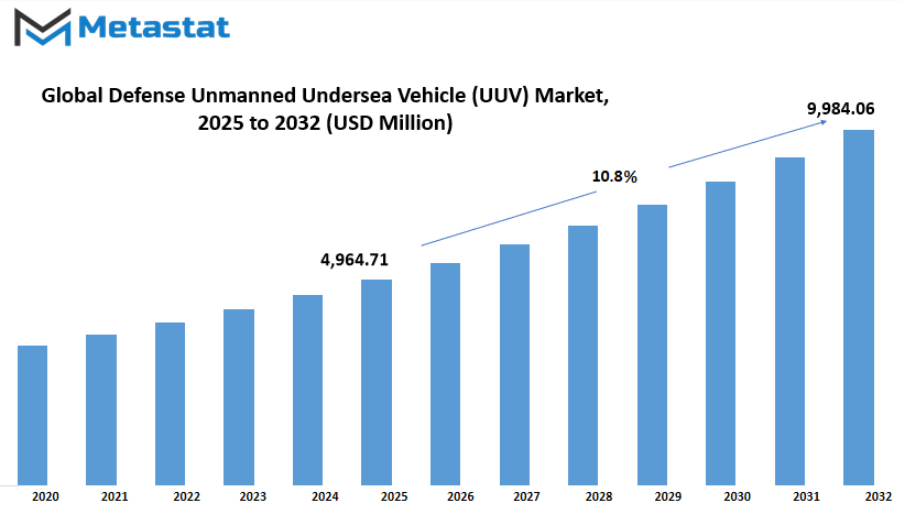
GROWTH FACTORS
The global defense unmanned undersea vehicle (UUV) market will also grow as nations put emphasis on improving maritime security and underwater defense capacity. Rising geopolitical tensions have necessitated the need for advanced naval technologies that can thrive in deep-sea environments with precision and stealthiness. This growing demand for advanced solutions will drive greater investment in innovative systems coded to detect, monitor, and defend underwater domains more effectively.
The need for persistent and covert maritime surveillance will also propel the global defense unmanned undersea vehicle (UUV) market forward. Modern warfare increasingly requires persistent monitoring of sensitive water zones, including vital trade routes and territorial waters. UUVs enable extended operation without endangering human lives, offering plausible intelligence in areas where traditional patrolling methods fail. This aspect will make such systems a hit with naval forces worldwide, subjecting it to increased demand over the next decade.
However, there are some hurdles that will prevent the widespread acceptance of these technologies. Considerable development and maintenance expenditures are a significant issue, especially for small nations with limited defense budgets. Building and maintaining advanced UUV platforms generally requires substantial investments and skilled technical expertise, which makes procurement difficult on a long-term basis. Furthermore, performance drawbacks such as constrained power delivery and communication issues in deep-water environments may constrain operational range and mission accomplishment, highlighting areas for technological advancement. Regardless of such obstacles, prospects in the global defense unmanned undersea vehicle (UUV) market of the future will be characterized by sensational innovation. Artificial intelligence and advanced sensor systems integration will provide more intelligent, more autonomous operations with reduced need for human surveillance of missions.
MARKET SEGMENTATION
BY Type
The global defense unmanned undersea vehicle (UUV) market is gaining significant attention due to its growing role in modern naval strategies. With the market valued at USD 2,792.68 million in 2025 and USD 2,172.02 million in earlier years, the steady rise reflects a shift toward advanced underwater solutions that will shape the future of defense operations. Rapid advancements in marine technology, combined with the need for enhanced security and surveillance, are driving consistent investment in this sector.
The global defense unmanned undersea vehicle (UUV) market is segmented by type, with Remotely Operated Vehicles (ROVs) and Autonomous Underwater Vehicles (AUVs) leading the demand. ROVs will continue to be vital for missions requiring human supervision, as they allow operators to control vehicles from the surface with precision. AUVs, on the other hand, will see faster growth due to their ability to conduct missions independently, making them valuable for intelligence gathering, reconnaissance, and mine countermeasure operations. The adaptability of these systems will ensure their integration into a wider range of defense applications in the coming years.
Future growth will be fueled by an increasing need for effective underwater monitoring, particularly in areas involving territorial security, subsea mapping, and resource protection. Modern naval forces are prioritizing underwater systems that can operate longer, cover greater distances, and deliver real-time data to support strategic decision-making. Enhanced battery performance, AI-driven navigation, and improved sensor technologies will further strengthen the reliability and efficiency of both ROVs and AUVs.
The rising demand for cost-effective and flexible underwater systems will encourage strong partnerships between defense agencies and technology providers. Countries will focus on developing advanced platforms that not only meet current security challenges but also prepare for future threats in complex marine environments. Continuous research and innovation will also push the market toward autonomous systems with higher endurance and enhanced communication capabilities, making underwater operations more effective and less dependent on human input.
Looking ahead, the global defense unmanned undersea vehicle (UUV) market will play an increasingly important role in naval modernization programs worldwide. Nations investing in underwater defense technology will gain a strategic edge, strengthening both offensive and defensive maritime capabilities. As underwater surveillance and threat detection become more critical, demand for advanced UUV systems will continue to grow, creating opportunities for innovation and collaboration across industries. The combination of technological progress, rising security needs, and international competition will ensure that the market maintains strong momentum well beyond 2025.
By Application
The global defense unmanned undersea vehicle (UUV) market is gaining steady attention as nations continue to focus on strengthening maritime security and advanced underwater operations. Modern conflicts and growing geopolitical tensions are driving greater demand for underwater systems that can function efficiently without direct human involvement. This market will continue to expand as technology becomes more refined, allowing undersea vehicles to operate with greater precision, range, and autonomy.
By application, this market is divided into several key areas. Intelligence, Surveillance, and Reconnaissance (ISR) remains one of the largest segments, as constant data collection and real-time monitoring are essential for securing coastlines and detecting threats. Mine Countermeasures play a vital role as well, reducing risks to naval forces and ensuring safer navigation in contested waters. Anti-Submarine Warfare (ASW) is another significant area, where undersea vehicles will continue to assist in locating and tracking submarines that could pose potential threats. Strike missions, although a smaller segment, are becoming increasingly sophisticated, with advanced systems capable of carrying out targeted operations below the surface. Port and Coastal Security operations highlight the importance of these vehicles in safeguarding critical entry points, while underwater mapping ensures accurate seabed data, useful for both defense and strategic planning. Other applications, such as payload delivery, will gain more relevance as newer designs allow for broader mission profiles.
The global defense unmanned undersea vehicle (UUV) market will benefit from rapid advancements in artificial intelligence, automation, and energy systems. These developments will enable longer missions, reduced operational costs, and higher reliability in challenging underwater conditions. Integration with other naval platforms will further increase operational efficiency, creating stronger multi-domain defense strategies. Growing investments from both established and emerging economies will accelerate innovation, leading to vehicles that can adapt to a wide range of operational needs.
Future growth will also be influenced by partnerships between defense organizations and technology developers. Collaborative efforts will drive progress in areas like autonomous navigation, secure communication, and sensor integration. Additionally, the push for enhanced environmental awareness will result in quieter, more efficient propulsion systems, reducing detection risks and increasing mission success rates.
As maritime threats continue to evolve, the global defense unmanned undersea vehicle (UUV) market will remain a critical component of naval strategy. From ISR operations to advanced strike capabilities, undersea vehicles will shape the future of defense by providing unmatched flexibility and operational strength. This market will not only transform how undersea missions are conducted but will also redefine the level of preparedness and adaptability required in modern naval forces worldwide.
|
Forecast Period |
2025-2032 |
|
Market Size in 2025 |
$4,964.71 million |
|
Market Size by 2032 |
$9,984.06 Million |
|
Growth Rate from 2025 to 2032 |
10.8% |
|
Base Year |
2024 |
|
Regions Covered |
North America, Europe, Asia-Pacific Green, South America, Middle East & Africa |
REGIONAL ANALYSIS
The global defense unmanned undersea vehicle (UUV) market is gaining significant momentum as advanced technologies continue to reshape modern defense strategies. This market is steadily transforming how underwater surveillance, reconnaissance, and security operations are conducted. Growth in this sector is driven by the rising demand for enhanced maritime security, efficient underwater communication systems, and advanced navigation technologies. As nations place greater focus on safeguarding territorial waters and ensuring strategic dominance, the need for UUVs will expand, pushing the market toward innovative solutions that balance performance, durability, and cost-efficiency.
Rapid advancements in artificial intelligence, automation, and underwater sensor systems are expected to play a key role in shaping the future of the global defense unmanned undersea vehicle (UUV) market. The integration of these technologies will make UUVs more adaptable, capable of operating in complex underwater environments with minimal human input. Increased investment in research and development is also fostering the creation of vehicles that offer longer operational endurance, improved stealth, and more precise data collection, ensuring better decision-making during missions.
Based on geography, the global defense unmanned undersea vehicle (UUV) market is segmented into North America, Europe, Asia-Pacific, South America, and the Middle East & Africa. North America, including the U.S., Canada, and Mexico, holds a strong position due to substantial defense budgets and a continuous focus on upgrading naval capabilities. Europe, with countries like the UK, Germany, France, and Italy, is emphasizing collaborative efforts and technological advancements to strengthen undersea operations. The Asia-Pacific region, which includes India, China, Japan, South Korea, and the Rest of Asia-Pacific, is witnessing rapid growth as territorial disputes and maritime security threats drive higher investments. In South America, led by Brazil and Argentina, modernization programs and the need for efficient surveillance systems are shaping market demand. Meanwhile, the Middle East & Africa, with GCC Countries, Egypt, South Africa, and the Rest of the region, is seeing gradual adoption, primarily for coastal monitoring and protection of critical underwater infrastructure.
Looking ahead, the global defense unmanned undersea vehicle (UUV) market will see continuous expansion as nations recognize the strategic importance of autonomous underwater systems. Strong collaborations between governments, defense agencies, and private industries will lead to more cost-effective and advanced solutions. The push for sustainable and energy-efficient technologies will also influence future designs, with UUVs expected to feature longer battery life and enhanced power management systems. As maritime challenges grow in scale and complexity, the role of these vehicles in defense operations will become even more critical, making this market a key driver of innovation in modern naval strategies.
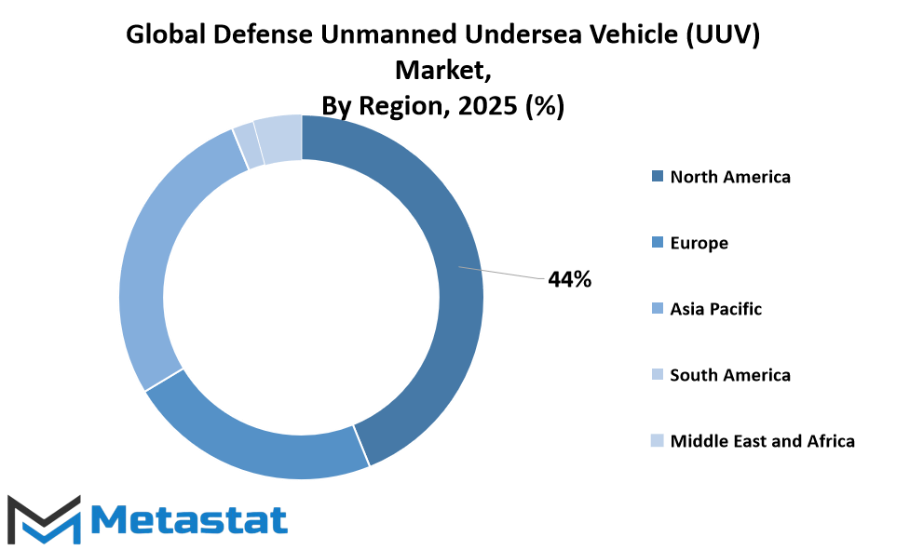
COMPETITIVE PLAYERS
The global defense unmanned undersea vehicle (UUV) market will continue to grow as advanced technologies shape modern naval strategies. With rapid advancements in autonomous systems, artificial intelligence, and undersea navigation, UUVs are becoming a central part of defense operations worldwide. These vehicles are being designed for multiple purposes, including surveillance, reconnaissance, mine detection, and strategic data gathering. Increased investments from leading defense organizations will drive stronger innovation, ensuring UUVs become faster, smarter, and more efficient in the years ahead.
As demand grows, major companies are pushing boundaries to deliver high-performance systems. Key players such as Kongsberg Discovery, Saab AB, Oceaneering International, Inc., Boeing, Teledyne Marine Technologies Incorporated, General Dynamics Mission Systems, BAE Systems plc, Atlas Elektronik GmbH, L3Harris Technologies, Inc., International Submarine Engineering Ltd., Northrop Grumman Corporation, Lockheed Martin Corporation, Huntington Ingalls Industries, Helsing GmbH, Boston Engineering, and ECA Group are expected to lead advancements that focus on endurance, stealth, and deep-water operational capability. These organizations are investing heavily in research and development to enhance energy efficiency, payload capacity, and operational range, creating systems that will address complex underwater missions with greater precision.
The global defense unmanned undersea vehicle (UUV) market will see greater integration of artificial intelligence to enhance autonomous decision-making, allowing vehicles to analyze surroundings in real time without direct human input. This shift will make UUVs more adaptable to unpredictable environments, reducing risks during missions and supporting naval dominance in contested areas. Additionally, the growth of secure underwater communication systems will enable better coordination between surface vessels, submarines, and unmanned platforms, strengthening undersea operations and strategic responses.
Future expansion will also be driven by rising geopolitical tensions and the growing need for coastal surveillance and territorial security. Governments will continue funding large-scale programs to enhance maritime defenses, and collaboration between defense organizations and technology firms will speed up innovation. This will open opportunities for new product developments and strategic partnerships, fostering a competitive market environment that supports continuous technological progress.
With increasing attention to sustainability and efficiency, battery technology will improve to support longer missions while reducing maintenance demands. Modular systems will allow quick reconfiguration of UUVs for specific tasks, offering cost-effective solutions for both large and small defense operators. As advancements accelerate, the global defense unmanned undersea vehicle (UUV) market will remain a critical area of innovation, shaping the future of undersea warfare and surveillance by delivering highly capable and reliable platforms designed to meet evolving security needs.
Defense Unmanned Undersea Vehicle (UUV) Market Key Segments:
By Type
- Remotely Operated Vehicles (ROVs)
- Autonomous Underwater Vehicles (AUVs)
By Application
- Intelligence, Surveillance & Reconnaissance (ISR)
- Mine Countermeasures
- Anti-Submarine Warfare (ASW)
- Strike Missions
- Port and Coastal Security
- Underwater Mapping
- Others (Payload Delivery, etc.)
Key Global Defense Unmanned Undersea Vehicle (UUV) Industry Players
- Kongsberg Discovery
- Saab AB
- Oceaneering International, Inc.
- Boeing
- Teledyne Marine Technologies Incorporated
- General Dynamics Mission Systems
- BAE Systems plc
- Atlas Elektronik GmbH
- L3Harris Technologies, Inc.
- International Submarine Engineering Ltd.
- Northrop Grumman Corporation
- Lockheed Martin Corporation
- Huntington Ingalls Industries
- Helsing GmbH
- Boston Engineering
- ECA Group
WHAT REPORT PROVIDES
- Full in-depth analysis of the parent Industry
- Important changes in market and its dynamics
- Segmentation details of the market
- Former, on-going, and projected market analysis in terms of volume and value
- Assessment of niche industry developments
- Market share analysis
- Key strategies of major players
- Emerging segments and regional growth potential




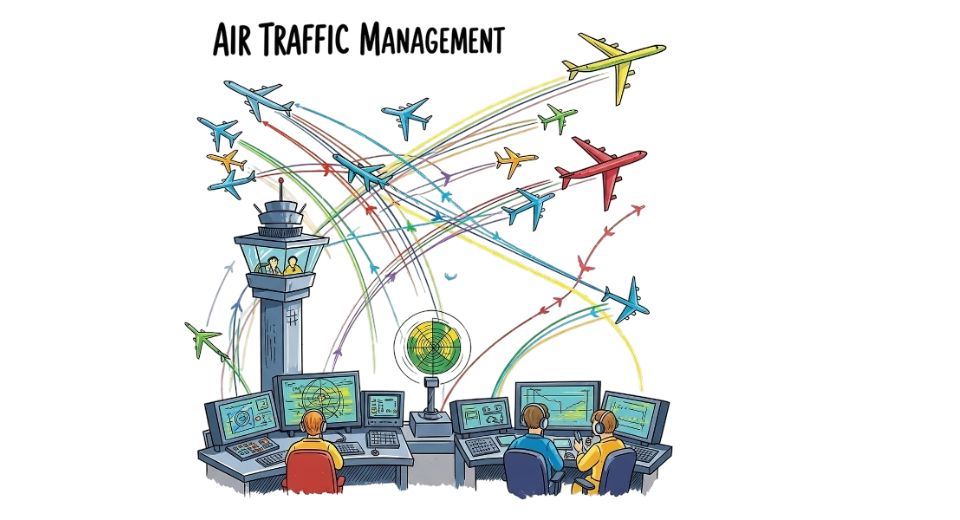

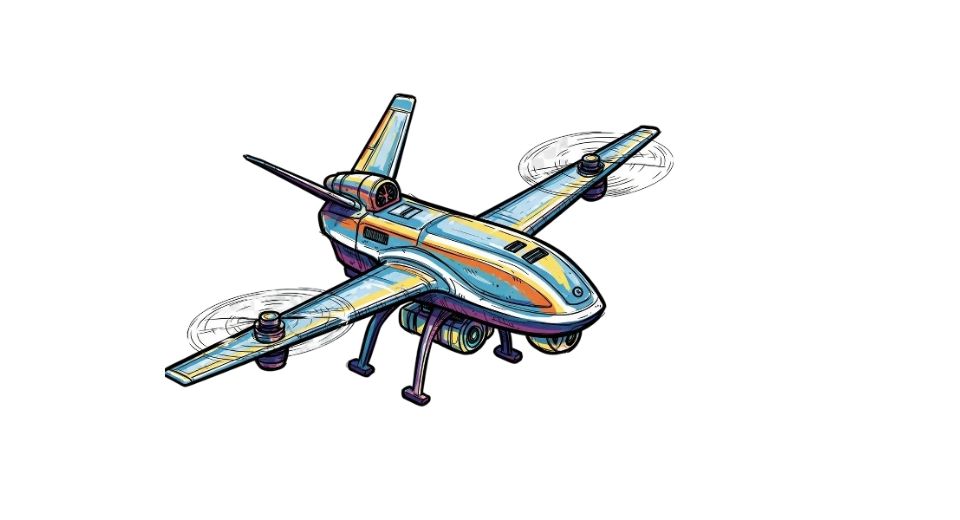
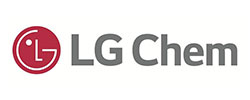

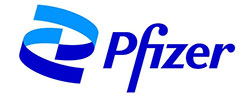

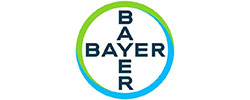


 US: +1 3023308252
US: +1 3023308252






